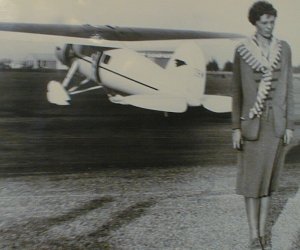Amelia Earhart
Today, we invent a hero. The University of Houston's College of Engineering presents this series about the machines that make our civilization run, and the people whose ingenuity created them.
Amelia Earhart and Charles Lindbergh looked like two peas from the same pod -- lean, shy, same mouth, same eyes, same short hair. In 1928, the year after Lindbergh flew the Atlantic, Earhart became the first woman to cross the ocean in a plane.
Philadelphia socialite Amy Guest had asked publisher George Putnam to organize a transatlantic flight in her own Fokker Trimotor. Putnam found a pilot to fly it. Then he interviewed women to find, and I quote, "[a] girl who would measure up to adequate standards of American womanhood." she would keep the flight log.
Earhart did her homework. Don't be too appealing -- that might cause Putnam to be protective. Don't make a big deal of the fact you're also a pilot -- they only want a second banana here.
So she showed up looking just like Charles Lindbergh and she kept her mouth shut. It worked -- she became the first woman to make the flight. She stepped out of the plane into a media maelstrom that never ended for her.
Earhart was the hottest story in the papers, even if she had only been a passenger. Putnam took on the role of publicist. He booked high-pressure speaking tours. He fed material to the press. He made it hard on competing women pilots. It was a peculiar symbiosis. He manufactured her fame. She rode that wave. Then she slowly began drowning in it.
Idealism drove Earhart. She started out to be a poet. She learned to fly from a rare woman instructor named Neta Snook in California. By the time she rode across the Atlantic, she was a seasoned pilot making her living as a social worker in Boston.
She married Putnam in 1930. It began as a marriage of convenience between two workaholics. But it grew into much more while the mad whirl continued. She finally flew the Atlantic solo in 1932. Earhart wished she had the mind-space to write more poetry, but she never had time to meet her own standards.
For nine years Putnam managed Earhart -- pushing an able pilot into the limelight over better fliers. Earhart used her bully pulpit to push things she believed in -- women's rights, pacifism -- and flight. Her last round-the-world flight had little real importance. If she'd made it, it would've been forgotten.
But she vanished at sea, and we've spent the last 60 years wondering what became of her. Was it cover for naval spying on the Japanese? One theory says Earhart used it to vanish from the public eye -- that she lived under another identity for years after.
It was probably just bungled navigation. Yet the dropping-out-of-sight theory reflects the sad truth of her plight. For she was shy, bright, and caught in the web of dubious success. And we're left to wonder: what might she've said in her book of poetry?
I'm John Lienhard, at the University of Houston, where we're interested in the way inventive minds work.
(Theme music)
Earhart, A., The Fun of It. New York: Brewer, Warren & Putnam, 1932.
Earhart, A., Last Flight. New York: Harcourt, Brace, & Co., 1937.
(George Putnam pieced this account of Earhart's last flight together from her telegraphed dispatches and published it a scant five months after her disappearance. I am grateful to The Detering Book Gallery for lending me a 1st edition of this odd book.)
Loomis, V.,V., and Ethell, J.L., Amelia Earhart: The Final Story. New York: Random House, 1985.
Lovell, M.S., The Sound of Wings: The Life of Amelia Earhart. New York: St. Martinís Press, 1989.
Ware, S., Still Missing: Amelia Earhart and the Search for Modern Feminism. New York: W.W. Norton and Company, 1993.
The Special Collections unit at Purdue University maintains a George Palmer Putnam Collection of Amelia Earhart Papers which I recommend to you:
http://www.lib.purdue.edu/spcol/aearhart/

Image courtesy of the Aviation Museums of North Texas